The Female Physique Webzine/Gallery
AND FITNESS CHAMPIONSHIPS
back to Flash Report
By Bill Dobbins
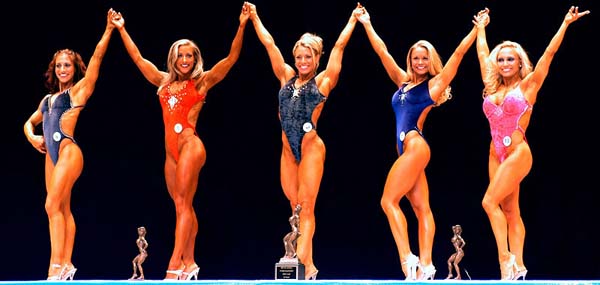
Lightweight Fitness Winners
INTRODUCTION
Welcome to South Beach. Don Johnson, with his faux Ferrari and sockless
loafers, was not anywhere in sight – although the town is full of Miami
Vice cast wannabes. And Miami in November is more about mild temperatures
and hazy winter light than it is tropical warmth and golden Florida sunshine. But
this was nonetheless a well-chosen location for the 2003 NPC Bodybuilding
and Fitness Championships, held November 14 and 15th – and we
are told the competition will return to this venue on a regular rotating
basis.
A temperate climate, lots of great restaurants and an easily accessible airport, Miami is not a bad place for a bodybuilding contest in November.
Once again, there were more women bodybuilders competing than fitness women. Given the wholesale flight from fitness to figure in the NPC this is to be expected. So far there don't seem to be any plans on the part of the federation to change the rules of fitness to give non-gymnasts a better chance in the performance round – or at least to decrease the importance of the routine in the scoring. Until or unless that happens, it seems that fitness might cease to exist in the NPC sometime soon, leaving this kind of competition to be sanctioned by organizations such as Ms. Fitness and Fitness America.
As usual, there was no figure contest as part of the Nationals. There is always something of a feeling of relief when this is the case, particularly on the part of the judges. It isn't that people dislike the look of figure competitors – they are certainly a toned and attractive group of women – but when you combine female bodybuilding, fitness and figure the contest seems to go on forever. You can only watch so many quarter turns until your eyes start to glaze over.
BODYBUILDING
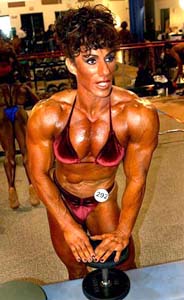 |
The 2003 Nationals will forever be known as the contest in which Annie Rivieccio finally earned her pro card. Annie has been competing since the late 1980s and has widely been regarded as the best amateur female bodybuilder not to have made it to the pros. Annie has always had the physique but has often not been in the best shape she was capable of – or just had the bad luck to show up looking great in a year that somebody else just a little better happened to be competing.
Actually, virtually all the women bodybuilders in all three classes were impressive. Whatever problems there are finding enough excellent fitness women at the national level, bodybuilding is not experiencing the same problem. For example, it used to be that the lightweight class seemed to consist mostly of competitors who should be middleweights but just weren't big enough. Not anymore. The lightweight class at the Nationals was exceptional, particularly Michelle Davis, who took first. It is hard to believe that Michelle only weighed 115 pounds. She has an incredible amount of dense muscle for somebody that light. And second place Tina Mulinazzi (aka Lindsay Mulinazzi, who has had the good sense to get out of fitness and switch to bodybuilding where she belongs – a decision many others should have made but haven't) tipped the scales at a mere 118 pounds, but looked terrific at that body weight.
The quality of the lightweight class was so good it once again called into question the decision of the IFBB to only allow two weight class in many pro contests – the Ms. Olympia and Ms. International shows in particular. What is the chance of success for a wonderful female bodybuilder weighing less than 120 pounds when competing in the same class as a bodybuilder of 135 lbs? The IFBB has claimed it wants to encourage women not to get “too big” (which also involves motivating them not to use drugs) and that was a major reason for their deciding to have the female pros compete in weight classes. But having only two classes rather than three limits the benefits of this strategy. But when promoters need to squeeze in three different kinds of competition – bodybuilding, fitness and figure – in one show, and to spend the extra expense and prize money that figure requires, the women bodybuilders end up being the losers.
It also shows a serious degree of disrespect to women bodybuilders that the federation and promoters would not realize how much more difficult bodybuilding is than figure, how much more time, effort and money succeeding in bodybuilding requires and the degree to which bodybuilding has a (paying) fan base compared to an event in which attractive, fit women parade around in bathing suits and do quarter turns. Witness the GNC Show of Strength dropping women's bodybuilding entirely in 2003 – a decision that turned out to be bad for both public relations and business.
There was certainly no reason to disrespect the middleweight class at the Nationals, any more than it would the lightweights. Tonia Williams, who placed 3rd at the 2002 USA, won the class decisively, with 1st place votes across the board. But Maya Stone and Anita Nikolich, who were second and third, were also first rate. So as with the lighter competitors, the top women in this class were all excellent bodybuilders and once again demonstrated the degree to which amateur bodybuilding for women is alive and well in the United States (and in the world, according to WPW Editor In Chief Steve Wennerstrom, who has found the same thing to be true internationally at the IFBB World Women's Championships).
One thing you could certainly say about the heavyweights is that they were BIG. Several of the women in this class were 170 pounds or more. But more than a half a dozen came it at less than 150 pounds, a sufficient difference that the NPC might soon have to add a super-heavyweight class. They are changing the weight divisions for next year (see below) but the huge difference in size among heavyweights will not be addressed.
As already discussed, Annie Rivieccio looked terrific – the best she ever has – and was the unanimous choice of the judges and the clear crowd favorite. She was the heavyweight champion and took the overall as well. Annie had been talking about the possibility of retiring if she didn't earn her pro card this year. Thankfully, that doesn't look as if it will happen. Welcome to the pros, Annie.
Second was Mimi Jabalee, who is one of those women who almost looks like too good an overall athlete to be a great bodybuilder. She is one of those competitors who needs to “fill out” to get the fullness of shape it takes to win top titles, but year by year she is coming closer to her goal. Mimi is somebody to watch for the future.
Laura Ottenad placed third in the heavweights. Laura has won the heavyweight title at the USA and is always a threat in any show she enters. As is true for Annie or any other top contender, it's all a matter of managing to come in looking in the best shape possible – a difficult task at this level.
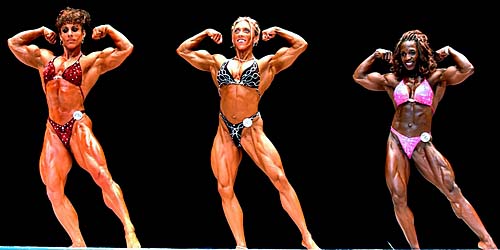 |
RULE CHANGES
At a meeting prior to the competition the NPC passed some rule changes for
2003. One is the inclusion of the front and rear lat spreads as part
of the women's compulsories. The
lack of lat spreads in NPC and IFBB contests all these years has been
something of a scandal, an example of needless and senseless gender discrimination. The
NPC is to be congratulated for correcting this situation.
Another change, as alluded to above, involves weight classes for women's bodybuilding. With so many competitors coming in at more than 160 or 170 pounds, the federation has decided to add a 4th class. The details of the new classes are as follows:
NEW WEIGHT CLASSES FOR WOMEN'S BODYBUILDING: The new weight classes for women's bodybuilding with four (4) classes are: Lightweight: Up to and including 115 Middleweight: Over 115 and up to and including 125 Light Heavyweight: Over 125 and up to and including 140 Heavyweight: Over 140 For all women's bodybuilding contests with three (3) classes: Lightweight: Up to and including 125 Middleweight: Over 125 and up to and including 140 Heavyweight: Over 140 For all women's bodybuilding contests with two (2) classes: Lightweight: Up to and including 125 Heavyweight: Over 125 |
FITNESS
There were three height classes at the Fitness Nationals, although it's
hard to understand what classes in fitness or figure are designed for. Weight
classes are invaluable in bodybuilding, but what “athletic” advantage or
disadvantage do they address in fitness/figure? The IFBB doesn't
use them in pro competition. Certainly, it allows the NPC and contest
promoters to include larger numbers of women in each show. Since
the competitors pay a fee to the NPC and a fee to the promoter, this obviously
increases revenue. But does it have anything to do with the actual
nature of the competitions?
One thing that is clear is the difference between the kind of physiques that score well in fitness and in figure. The ideal figure body – on average – is that of a model with long proportions. Fitness bodies are much more compact, in part because that is the kind of structure it takes to do well in gymnastics. Look at pro champions like Susie Curry and Kelly Ryan and you get the idea.
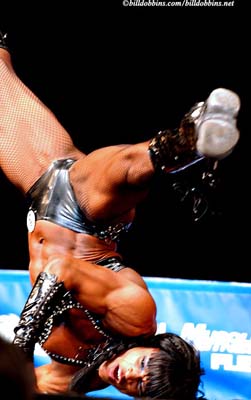 |
However, there is some indication that the NPC is starting to award higher scores to fitness routines that aren't gymnastics based. A good example is Vickie Newton, who placed 5th in the tall class. Vickie doesn't have anything like a typical fitness physique (at the USA she looked as if she were there to compete in bodybuilding; at the Nationals she had lost not only size but some degree of shape as well, but still didn't have a physique most would associate with fitness). Vickie placed 2nd in the routine round, although her performance is all strength and athleticism and virtually no gymnastics at all. In fact, this kind of performance is one that most athletically gifted fitness competitors could aspire to emulate.
If the NPC is going to keep giving higher scores to non-gymnastics routines it would be a good idea for them to make that known to potential competitors. As more women try figure and find out to what degree it is based on genetics, with very little that can be accomplished by most competitors through effort, hard work and discipline, many non-gymnasts but excellent athletes would be tempted to come back to the ranks of fitness if they felt they could score reasonably well in the performance round.
Of course, there is nothing to criticize about the fitness winners at the 2003 Nationals. Carla Fred barely beat out Jenni Allen in the short class – finishing a place behind in the two-piece round and a place ahead in the routine and one-piece round. It was a very close contest between two excellent and attractive female athletes.
But this does bring up a familiar question: What are women doing wearing suits that cover up their torsos in a physique-based contest? Why should you give points to a competitor who looks better when you can't actually see her body? This seems to be a case of trying to make the contest appear to be more than it is. It would be more instructive to the judges to see fitness women on stage in thongs than in camouflaging one-piece suits.
It would also cut down length of the show, since it takes time to change outfits. And having to have only one suit made instead of two would make it less expensive for the fitness competitors. But considering the horrendous length of most women's physique contests, and the frequent need to rush through the proceedings (often, it seems, at the expense of bodybuilding) anything that makes the contests shorter would be a good idea.
The medium class outcome is a good example of the difference between judging competitors wearing one-piece and two-piece suits. Lydia Haskell, the winner of the class, won the bikini round. Second place winner Amy Huber placed 4th in round 1, but was second in the one-piece round. Generally the women who look more athletic (great abs, for example) do much better in bikinis while those with nice symmetry but less muscle excel wearing a one-piece suit. A one-piece covers up faults as well as a lack of detailed muscle.
If this seems to add up to a lot of judging confusion, then try factoring in the performance round: Megan Tennant, who placed first in performance, didn't even make the top 5 in the finals. She was 14th in the bikini round. All this illustrates why people are always commenting that they don't understand what fitness judging is all about. When you try to balance out the rounds wearing different suits, which radically change the look of the physique, plus the performance round – which has little to do with physique at all – it is no wonder that it is virtually impossible for the audience to look at a lineup and have any good idea who is going to place where.
In the fitness tall class you frequently don't see the depth you get in the shorter classes. With any kind of physique contest, taller competitors normally have trouble filling out their bodies and getting the same quality of shape as do shorter ones. The tall class at the Nationals certainly wasn't bad, but as you might expect the fall off in quality was somewhat steeper than in the shorter divisions.
Shannon Dey was the winner, finishing 3rd in the bikini round, 2nd in the two-piece and winning in performance. Her routine is obviously what gave her the title, since 2nd place Melissa Babers won both physique rounds but was down in 6th with her performance. Again, without knowing how the judges scored the routines (and with so many routines, going on for so long, how could you?) there is no way for the audience to predict the outcome.
There is bound to be some audience dissatisfaction in an event – sanctioned by a physique federation – in which you can't make an informed guess as to who is going to win just by looking at the competitors and in which the best physique doesn't take the title.
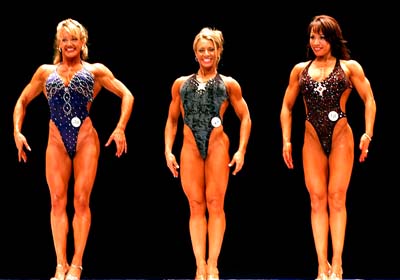 |
In bodybuilding, the bigger classes winners have an advantage over the smaller ones – which is why Annie Rivieccio won the bodybuilder overall so easily. In fitness it is often the opposite – with the short or medium winner having an advantage. In this case the overall title was taken by short class champion Carla Freda, with a very pleasing balance and symmetry to her physique and a very attractive overall look, that made her the winner. Shannon, as you can see in the accompanying illustration, looks more like a bodybuilder standing beside the other two.
RECOMMENDATIONSWhat then is the future of NPC fitness? There certainly is a serious dearth of new competitors coming up through the ranks. My recommendations for dealing with this would be:
(1) Do away with the one-piece round, only judge the women in bikinis and make it clear you are looking for muscle – muscle that isn't too big and that is as beautiful as possible – but actual muscle. For women who don't want muscle, there is always figure. Fitness women should look as if they could be small bodybuilders if they chose to make the effort. Think Monica Brant or Timea Majorova.
(2) Make the performance round about athletic grace, have less gymnastics and – even more – make tumbling against the rules. There was one potentially serious incident at the GNC in 2003, there have been all sorts of dislocations, bruises and sprains, and its only a matter of time before somebody get seriously hurt. Physique competitions don't need tumbling. If anyone is that much interested in gymnastics, go to a gymnastics meet. That is not what the NPC should be all about.
Remember that seeming competitors to NPC fitness such as Fitness America and the Ms. Fitness contests are not sports federations, don't provide the same kind of long-term support for athletes and are not really geared toward satisfying a paying audience. They are producing television shows, and that's all they care about. Since the NPC has different goals and obligations, it shouldn't pattern its events on those of these other organizations. The middle name of the “National Physique Committee” is physique, and that shouldn't be forgotten.